
In the garden it’s important to look for plants that are drought tolerant rather than drought resistant because drought-tolerant plants require less water to survive, writes gardening columnist CEDRIC BRYANT.
THE pollies told us the rebuilt Cotter Dam would give Canberra certainty of water supply and we wouldn’t be exposed to the sort of difficulties of the 2003-2012 drought for a very long time.

And yet with the city’s ever increasing numbers of houses and population, that prediction may prove incorrect.
Therefore, in the garden it’s important to look for plants that are drought tolerant rather than drought resistant.
Drought-tolerant plants require less water to survive.
For starters, we can look at plants from the driest parts of the globe, for example Mexico, California, the Mediterranean and South Africa.
A familiar example is the Mexican orange blossom (Choisya ternata), so called because of the similarity of its fragrance to that of orange-tree flowers.
When we bought a previous home, one such plant was growing in the garden in a spot nowhere near any taps for watering and the only water it received was from rain. And yet it survived and produced the mass of white flowers each late winter and spring every year. In the 10 years we lived there it never received water other than rain.
Besides the original Choisya species there are many cultivars produced with plant breeding. One such new cultivar is Choisya White Dazzler with all the benefit of drought resistance combined with an even greater flush of white fragrant flowers.
There is also Escallonia “Hedge with an Edge” with pink flowers. Escallonias thrive in the heat, originating in South America, although have adapted well in California. Both grow to about 1.2m x 1m, although can be clipped to keep lower.
WHILE debate continues around possible health issues associated with the handling of the weedkiller glyphosate, a reminder that there’s an organic alternative called Slasher.
It was developed in Australia in 2016 from plant extracts with no lasting soil residue.
It is manufactured by the Australian company Organic Crop Protectants, which manufactures a range of certified organic products for home gardeners and farmers under the name of Eco products.
The company says Slasher can be used in veggie gardens with no withholding period. It is approved by the Australian Certified Organic.
Slasher is not systemic; rather, it is a contact-only spray and good coverage is necessary for best results and some tough, well-established and perennial weeds may need a repeat application. I’ve been trialling it at home for many months and can recommend it.
Jottings…
- Growing carnivorous plants in Canberra is the focus of the next meeting of the Canberra Horticultural Society at Wesley Church Centre, Forrest, 7.30pm, Monday, July 15. All welcome.

Learn how to prune roses and fruit trees late this month. - Rose and fruit tree pruning demonstrations will be held at the Horticultural Society’s Trial Garden, corner of Battye and Purdie Streets, Bruce, 10am-noon, Saturday, July 27.
- There will be a rose-pruning demonstration at 1 Spence Street, Hughes, 1pm-3pm, Sunday, July 28.
Who can be trusted?
In a world of spin and confusion, there’s never been a more important time to support independent journalism in Canberra.
If you trust our work online and want to enforce the power of independent voices, I invite you to make a small contribution.
Every dollar of support is invested back into our journalism to help keep citynews.com.au strong and free.
Thank you,
Ian Meikle, editor




Leave a Reply